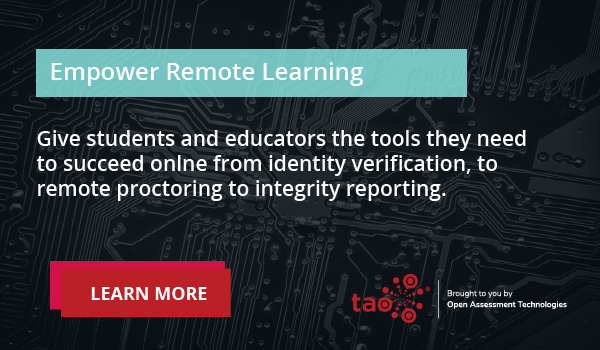With the need for distance learning quickly becoming a necessity, the K12 adoption of technology has evolved. In particular, the way schools assess students has taken a major leap when it comes to innovation, leaning toward technology like artificial intelligence (AI) and machine learning (ML).
In the meantime, the educators’ perspective on testing has remained consistent: assessments have to parallel classroom instruction and reflect the real-life scenarios students may encounter. In addition, instead of mere fact recollection, teachers are calling for a holistic measure of students’ skills and knowledge.
More importantly, teachers consider the timing to be a crucial aspect of assessments — considering not only alignment with instruction but also the scheduling of testing itself.
To demonstrate this belief, teachers state the following example: instead of testing at a specific time at the end of a semester or school year, the test should be administered when the student is ready to demonstrate their skills of a specific skill or concept.
Because of technology innovation, this type of assessment is possible. Paper and pencil testing is no longer the only option; adaptive tests, carried out through technology, can create an engaging, accessible assessment which comes to students at the exactly right time.
Personalization is key to creating tests that accommodate individual students. Because of technology, students can dive into adaptive, computer-based tests that provide a more specific, actionable measure of a student’s knowledge.
With adaptive testing, the test itself conforms to the specific ability and level of a particular student; in turn, such a test allows the educator to gain a more in-depth understanding of where the student needs most help — and offer them an optimal path toward success.
Developments in gaming technology provide the resources and innovation for computer-based tests.
AI and ML in educational assessment make this technological approach possible; students can take tests that are personalized for their skill level, while teachers gain a deeper understanding of student progress, which informs classroom learning. Plus, students and education leaders alike gain better data to push forward educational measures — without having to rely on inconsistent, paper-based reviews of student performance.
How to Boost Learning During Assessment with AI and ML Technology
Engagement plays a major role in accurately measuring, and achieving, student mastery of one subject or another. With inconsistent, paper-based assessments, the level of engagement can be difficult to measure and understand. AI-based learning, on the other hand, not only tends to be customized per student, which in turn increases engagement, but can also alert the educator when engagement levels drop.
In turn, this allows teachers to connect engagement levels with performance, which no doubt can raise the stakes for administration when it comes to in-classroom learning.
AI in educational assessment allows measuring of performance through score constructed responses, so teachers no longer have to spend time on time-consuming hand scoring. Instead, they can analyze large pools of student data to understand overall performance or specific patterns. Plus, they can easily track individual learning progressions, customizing learning paths per student need.
Efficiency and accuracy are at the forefront of measuring assessment success. AI allows students to define a problem and find a solution — leaving the educator with clear data on how to proceed both during the instruction and for future tests.
Other Considerations of AI in Educational Assessment
Augmented and virtual reality take a big chunk of the success of AI in educational assessment. These technologies can provide real-world scenarios that allow students to test their knowledge first hand. Plus, these types of scenarios offer teachers a wider range to measure student success: they allow students to test and apply their knowledge to unique situations which they may encounter in their professional or academic careers.
Technology allows testing to be more timely, accessible and reliable. In addition, advancements in AI and ML can expose students to a wider range of information, experience, and technical approaches than the pencil-and-paper alternatives. This evens the playing field for students that may not have the same opportunities as their more wealthy or otherwise privileged counterparts.
In short, technology enables a more accurate and fair representation of the individual student’s knowledge; moreover, it allows more students to experience more real-life scenarios, and even more equitable testing, than ever before. Technology-enabled assessments deliver a clearer picture of the path toward knowledge, while also providing an equal opportunity to learn for students of all backgrounds and abilities.

